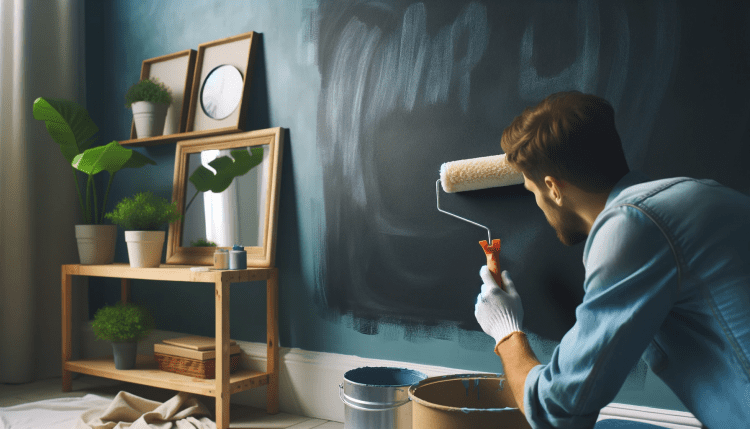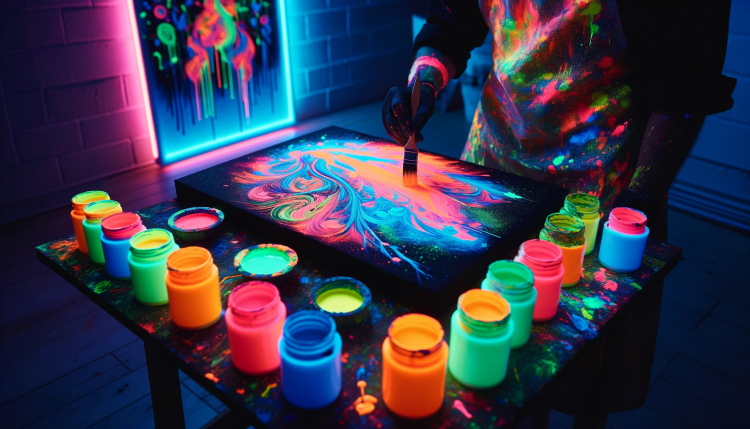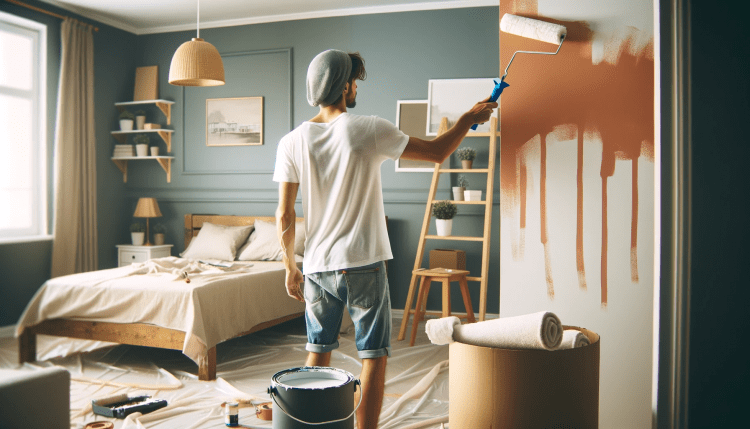
Painting is not just about choosing a color; it’s also about selecting the right type of paint for your project. From homes to art projects, the type of paint you choose can significantly impact the outcome. This guide explores the various types of paints available, their unique properties, and their best use cases.
Common Household Paints
Water-Based Paints (Latex)
- Overview: Popular for interior walls, latex paint is known for its ease of use and quick drying times.
- Best For: General indoor painting projects, especially in living areas and bedrooms.
Oil-Based Paints (Alkyd)
- Overview: Renowned for its durability and rich finish, oil-based paint is often chosen for its longevity.
- Best For: High-traffic areas, wood trims, and surfaces requiring frequent cleaning.
Acrylic Paints
- Overview: A versatile choice, acrylic paints are used for both artistic purposes and home projects.
- Best For: A variety of surfaces, including canvas, wood, and metal, both indoors and outdoors.
Specialty and Functional Paints

Chalkboard Paint
- Overview: Transforms surfaces into writable chalkboards.
- Best For: Kids’ rooms, kitchens, or creative spaces in homes and schools.
Magnetic Paint
- Overview: Creates a surface that magnets can stick to, ideal for interactive walls.
- Best For: Playrooms, offices, or organizational walls in kitchens.
Glow-in-the-Dark Paint
- Overview: Absorbs light and glows in the dark, adding a whimsical touch.
- Best For: Children’s bedrooms, creative decor, or safety markings.
High-Performance and Protective Paints
Epoxy Paint
- Overview: Known for its resistance to chemicals and stains, epoxy is a hardy paint.
- Best For: Garages, warehouses, and industrial floors.
Fire Retardant Paint
- Overview: Slows down the spread of fire, providing an additional layer of safety.
- Best For: Commercial buildings, public spaces, and areas prone to high heat.
Anti-Condensation Paint
- Overview: Helps reduce condensation and mold growth.
- Best For: Kitchens, bathrooms, and damp areas.
Decorative and Artistic Paints

Metallic Paint
- Overview: Gives a shiny, metal-like finish.
- Best For: Decorative accents, art projects, and feature walls.
Fluorescent Paint
- Overview: Bright, neon colors ideal for artistic and special effects.
- Best For: Art installations, party rooms, and creative projects.
Cement Paint
- Overview: Durable and water-resistant, perfect for exterior walls.
- Best For: Outdoor walls, basements, and other masonry surfaces.
Innovative and Niche Paints
Anti-Slip Paint
- Overview: Adds grip to surfaces to prevent slipping.
- Best For: Stairs, pool decks, and other areas where slip resistance is crucial.
Soundproof Paint
- Overview: Contains sound-dampening properties to reduce noise transmission.
- Best For: Home theaters, bedrooms, and shared walls in apartments.
Polyurethane Paint
- Overview: Offers a durable and resistant finish, often used in harsh environments.
- Best For: Floors, machinery, and outdoor furniture.
Environmentally Friendly Options

Linseed Oil Paint
- Overview: Made from natural materials, it’s an eco-conscious choice.
- Best For: Wood surfaces, both interior, and exterior, for those preferring natural products.
Milk Paint
- Overview: Non-toxic and biodegradable, milk paint offers a vintage look.
- Best For: Furniture and surfaces where a matte, chalky finish is desired.
Eco-Friendly Paints
- Overview: Low or no VOCs, safer for indoor air quality.
- Best For: Any interior space, especially in homes with children, pets, or allergy sufferers.
Highly Specialized Paints
Bituminous Paint
- Overview: Waterproof and anti-corrosive, ideal for specific outdoor applications.
- Best For: Metal structures, underwater pipelines, and external surfaces prone to moisture.
Anti-Graffiti Paint
- Overview: Allows for easier removal of graffiti, maintaining the aesthetic of public spaces.
- Best For: Exterior walls of buildings in urban areas.
Rubber-Based Paint
- Overview: Flexible and weather-resistant, suitable for various outdoor applications.
- Best For: Coating outdoor furniture, play equipment, and surfaces needing elasticity.
Exploring the Pros and Cons of Different Paints
The world of paint is vast and full of options, each serving a unique purpose. From enhancing the aesthetics of a space to providing functional benefits like protection and safety, the right type of paint can make all the difference. Understanding these varieties helps in making informed decisions that align with your project’s goals, whether you’re renovating a room, tackling an outdoor project, or embarking on an artistic endeavor.
Each type of paint brings unique benefits and is designed for specific applications. Whether for safety, functionality, or aesthetic purposes, understanding these various types can help you choose the right paint for your project’s specific needs and goals. Let’s take an in-depth look at some of the many varieties of paints available.
Water-Based Paints (Latex)
Pros:
- Quick Drying: Latex paints dry faster than oil-based, allowing for quicker recoating.
- Easy Clean-Up: Cleaning up is simple with just soap and water.
- Low VOCs: Generally, they have lower levels of volatile organic compounds (VOCs), making them more environmentally friendly and less odorous.
- Flexibility: Less prone to cracking and peeling, as they can expand and contract with the surface.
- Color Retention: Resistant to fading and yellowing over time.
Cons:
- Less Durable: May not be as tough as oil-based paints, making them less suitable for high-traffic areas.
- Poor Adhesion on Dirty Surfaces: Requires clean and primed surfaces for best results.
Oil-Based Paints (Alkyd)
Pros:
- Durability: Offers a tough, long-lasting finish, ideal for high-traffic areas and surfaces that require frequent cleaning.
- Smooth Application: Tends to go on more smoothly, providing a more uniform finish.
- Better Adhesion: Works well on dirty, chalky surfaces, and even rusty metal.
- Rich Finish: Often yields a more lustrous finish than latex paints.
Cons:
- Longer Drying Time: Takes longer to dry, which can be inconvenient and slow down projects.
- Strong Odor and VOCs: Contains higher levels of VOCs, resulting in a strong odor and potentially harmful fumes.
- Requires Solvents for Clean-Up: Needs turpentine or mineral spirits for cleaning brushes and spills.
- Prone to Yellowing: Can yellow over time, especially in low-light conditions.
Specialty Paints
Chalk Paint
- Pros: Requires no prep work and adheres well to most surfaces. It gives a matte, vintage look.
- Cons: More expensive than regular paint and may require wax or sealant.
Magnetic Paint
- Pros: Can transform a wall into a magnetic surface, ideal for kids’ rooms or offices.
- Cons: Requires multiple coats for good magnetism, and the final finish can be somewhat gritty.
Eco-Friendly Paints
- Pros: Low or no VOCs, making them safer for the environment and indoor air quality.
- Cons: Can be more expensive and might offer a more limited color range.
Acrylic Paints
Pros:
- Versatile: Suitable for a wide range of surfaces, including canvas, wood, and metal.
- Quick Drying: Dries faster than oil paints, making it ideal for layering techniques.
- Water-Resistant: Once dry, it’s water-resistant, although it can be diluted with water when wet.
- Vibrant Colors: Offers bright, vibrant colors that maintain their hue over time.
Cons:
- Drying Time: Can dry too quickly for some techniques, which might require a retarder to slow the drying process.
- Less Blending Time: The rapid drying limits the time available for blending colors.
Enamel Paints
Pros:
- Durability: Highly durable, making it suitable for outdoor projects and surfaces exposed to harsh conditions.
- Hard Finish: Provides a hard, glossy finish that is resistant to stains and scratches.
- Water-Resistant: Excellent for surfaces that require regular cleaning.
Cons:
- Toxic Fumes: Generally have strong odors and can release toxic fumes.
- Slow Drying: Takes longer to dry compared to other paints.
Latex-Acrylic Hybrid Paints
Pros:
- Best of Both Worlds: Combines the easy clean-up of latex with the durability of acrylic.
- Good Adhesion: Works well on a variety of surfaces.
- Low VOCs: Typically lower in VOCs than traditional oil-based paints.
Cons:
- Cost: Can be more expensive than standard latex or acrylic paints.
Milk Paint
Pros:
- Eco-Friendly: Made from natural ingredients, non-toxic, and biodegradable.
- Vintage Look: Provides a unique, matte finish that can be ideal for antique furniture and rustic projects.
Cons:
- Limited Shelf Life: Once mixed, it has a limited shelf life and must be used quickly.
- Surface Preparation: May require a bonding agent or primer on non-porous surfaces.
Epoxy Paint
Pros:
- Extremely Durable: Resistant to chemicals, stains, and moisture, making it ideal for floors and countertops.
- Sealing Properties: Acts as a sealant on concrete and other surfaces.
Cons:
- Complex Application: Typically involves mixing two components and has a limited working time once mixed.
- Ventilation Required: Produces strong fumes; adequate ventilation is necessary.
Spray Paint
Pros:
- Even Application: Provides a smooth, even coat without brush marks.
- Fast and Efficient: Ideal for covering large areas or intricate objects quickly.
- Versatility: Suitable for a variety of surfaces, including metal, wood, plastic, and more.
Cons:
- Ventilation Needed: Releases fumes, requiring good ventilation.
- Overspray: Can be messy and difficult to control, leading to overspray.
Chalkboard Paint
Pros:
- Functional Surface: Creates a writable and erasable chalkboard surface on walls, furniture, or decor.
- Creative Applications: Great for children’s rooms, kitchens, or offices.
Cons:
- Surface Prep: Requires a smooth, well-prepared surface for best results.
- Regular Maintenance: Chalk dust can be messy; the surface may need regular cleaning.
Glow-in-the-Dark Paint
Pros:
- Unique Effect: Absorbs light and glows in the dark, adding a whimsical or practical element to rooms or objects.
- Safety Applications: Useful for safety markings, children’s rooms, and creative decor.
Cons:
- Limited Brightness and Duration: The glow may not be very bright and often fades relatively quickly.
- Specific Conditions: Requires exposure to light to ‘charge’ the glow effect.
Metallic Paint
Pros:
- Aesthetic Appeal: Gives a metallic finish that can mimic the look of metal.
- Decorative Accents: Ideal for creating a focal point or decorative details.
Cons:
- Application Technique: Can show brush strokes or imperfections if not applied correctly.
- May Require Multiple Coats: Often requires several coats for a uniform finish.
Textured Paint
Pros:
- Visual Interest and Depth: Adds texture to walls or surfaces, hiding imperfections.
- Variety of Textures: Available in different textures like sand, popcorn, or stone effects.
Cons:
- Difficult to Apply and Remove: Application can be challenging and removing or changing the texture later is labor-intensive.
Heat-Resistant Paint
Pros:
- Withstands High Temperatures: Ideal for surfaces exposed to high heat, like radiators, grills, or engine parts.
- Protects Surfaces: Helps in protecting the material underneath from heat damage.
Cons:
- Limited Color Options: Often available in a more restricted range of colors.
- Specialized Use: Not typically necessary for general home painting projects.
Cement Paint
Pros:
- Durability: Excellent for exterior walls, providing durability against weather elements.
- Waterproof: Offers water-resistant properties, making it suitable for damp areas.
Cons:
- Surface Preparation: Requires thorough surface preparation for proper adhesion.
- Limited Finish Options: Typically offers a more matte finish.
Linseed Oil Paint
Pros:
- Natural Ingredients: Made primarily from linseed oil, it’s eco-friendly and less toxic.
- Durable Finish: Provides a strong, long-lasting finish, especially for wood surfaces.
Cons:
- Long Drying Time: Takes longer to dry compared to synthetic paints.
- Regular Maintenance: May require reapplication or maintenance over time.
Bituminous Paint
Pros:
- Waterproof and Anti-Corrosive: Ideal for underwater steel structures, pipelines, and exteriors.
- Versatile: Can be applied to most surfaces, including metal and concrete.
Cons:
- Limited to Certain Surfaces: Not suitable for surfaces that come into contact with potable water or in living spaces.
- Dark Finish: Generally available in black or dark colors.
Anti-Condensation Paint
Pros:
- Prevents Condensation: Ideal for kitchens and bathrooms, where condensation is a common issue.
- Mold Resistance: Helps in reducing the growth of mold and mildew.
Cons:
- Specific Use: Mainly used in areas prone to high humidity.
- May Require Additional Ventilation: Does not replace the need for proper ventilation in damp areas.
Anti-Graffiti Paint
Pros:
- Graffiti-Resistant: Either repels graffiti or makes it easier to clean without damaging the underlying surface.
- Protective: Used on public buildings and structures for easy maintenance.
Cons:
- Cost: Can be more expensive than regular exterior paints.
- Application: May require a specialized application process.
Rubber-Based Paint
Pros:
- Flexibility: Excellent for surfaces that expand and contract, like outdoor furniture.
- Weather Resistant: Durable against weathering and UV light.
Cons:
- Surface Compatibility: Not suitable for all surface types, especially indoor use.
- Odor: Can have a strong odor during application.
Anti-Slip Paint
Pros:
- Safety Feature: Adds traction to floors, reducing the risk of slips and falls.
- Versatile Application: Can be used on stairs, decks, poolsides, and other areas where slip resistance is important.
Cons:
- Texture: May feel rough underfoot, which some may find uncomfortable.
- Aesthetic: The gritty texture might not suit all design preferences.
Fluorescent Paint
Pros:
- Vibrant Colors: Bright, neon colors that glow under ultraviolet light.
- Creative Uses: Ideal for artistic projects, signage, or safety markings.
Cons:
- Limited Lightfastness: Can fade when exposed to sunlight over time.
- Niche Application: More suitable for specific artistic or decorative purposes.
Fire Retardant Paint
Pros:
- Safety: Can slow the spread of fire, providing additional time for evacuation.
- Building Compliance: Often used in commercial buildings to meet fire safety standards.
Cons:
- Not Fireproof: It doesn’t prevent fires but delays the spread.
- Specialized Use: Primarily used in commercial or public buildings.
Peelable Paint
Pros:
- Temporary: Can be peeled off when no longer needed, making it ideal for temporary projects or rental properties.
- Protective: Protects the underlying surface from scratches and stains.
Cons:
- Durability: Not as durable as permanent paints.
- Application: Requires careful application for easy removal later.
Reflective Paint
Pros:
- Visibility: Reflects light, increasing visibility for safety signs, road markings, and outdoor items.
- Versatile: Can be applied to various surfaces like metal, wood, and concrete.
Cons:
- Specialized Use: Primarily for safety and directional signage.
- Cost: Can be more expensive than standard paint types.
Insulating Paint
Pros:
- Energy Efficiency: Claimed to provide thermal insulation, potentially reducing heating and cooling costs.
- Ease of Use: Applied like regular paint.
Cons:
- Effectiveness Debate: The insulating effect may be less significant than traditional insulation methods.
- Cost: Generally more expensive than conventional paint.
Magnetic Paint
Pros:
- Functional: Creates a surface that magnets can stick to, great for walls in playrooms, offices, or kitchens.
- Base Layer: Can be used as a base coat, over which you can paint a standard color.
Cons:
- Multiple Coats Needed: Requires several coats for strong magnetic effect.
- Dark Color: Typically comes in darker colors, which may limit design choices if used as a top coat.
Soundproof Paint
Pros:
- Noise Reduction: Contains sound-dampening compounds that can reduce echo and noise transmission.
- Easy Application: Applied similarly to regular paint.
Cons:
- Limited Soundproofing: Not as effective as traditional soundproofing methods.
- Thickness: Requires multiple, thick coats to be effective.
Polyurethane Paint
Pros:
- Durability: Highly durable and resistant to chemicals and abrasion.
- Finish Options: Available in various sheens, from matte to high gloss.
Cons:
- Application Care: Requires careful application to avoid bubbles and brush marks.
- Drying Time: Generally has a longer drying time.
Silicone Paint
Pros:
- Weather Resistant: Excellent for exterior surfaces, providing resistance to harsh weather conditions.
- Flexibility: Maintains elasticity, reducing the risk of cracking.
Cons:
- Surface Compatibility: Best suited for exterior surfaces; not commonly used indoors.
- Cost: Can be more expensive than standard exterior paints.
Non-Skid Paint
Pros:
- Safety Feature: Contains particles that create a rough surface, preventing slipping.
- Use Cases: Ideal for boat decks, stairs, and other areas where slip resistance is important.
Cons:
- Texture: The rough texture might be uncomfortable for bare feet.
- Limited Colors: Often available in a limited range of colors.
Plastisol Paint
Pros:
- Durability: Forms a durable, plastic-like coating, often used in industrial applications.
- Protective: Provides excellent protection against corrosion and wear.
Cons:
- Specialized Use: Mainly used for coating metal surfaces, not suitable for general home painting.
- Application Method: Typically applied through dipping or spraying, requiring professional equipment.

Different Paints for Different Needs
Each of these paints serves a specific purpose, from enhancing functionality and safety to meeting specific aesthetic requirements. The choice of paint largely depends on the nature of your project, the surface you’re working with, and the environmental conditions it will face.




